Submitted:
25 January 2024
Posted:
26 January 2024
You are already at the latest version
Abstract
Keywords:
1. Introduction
2. Study area
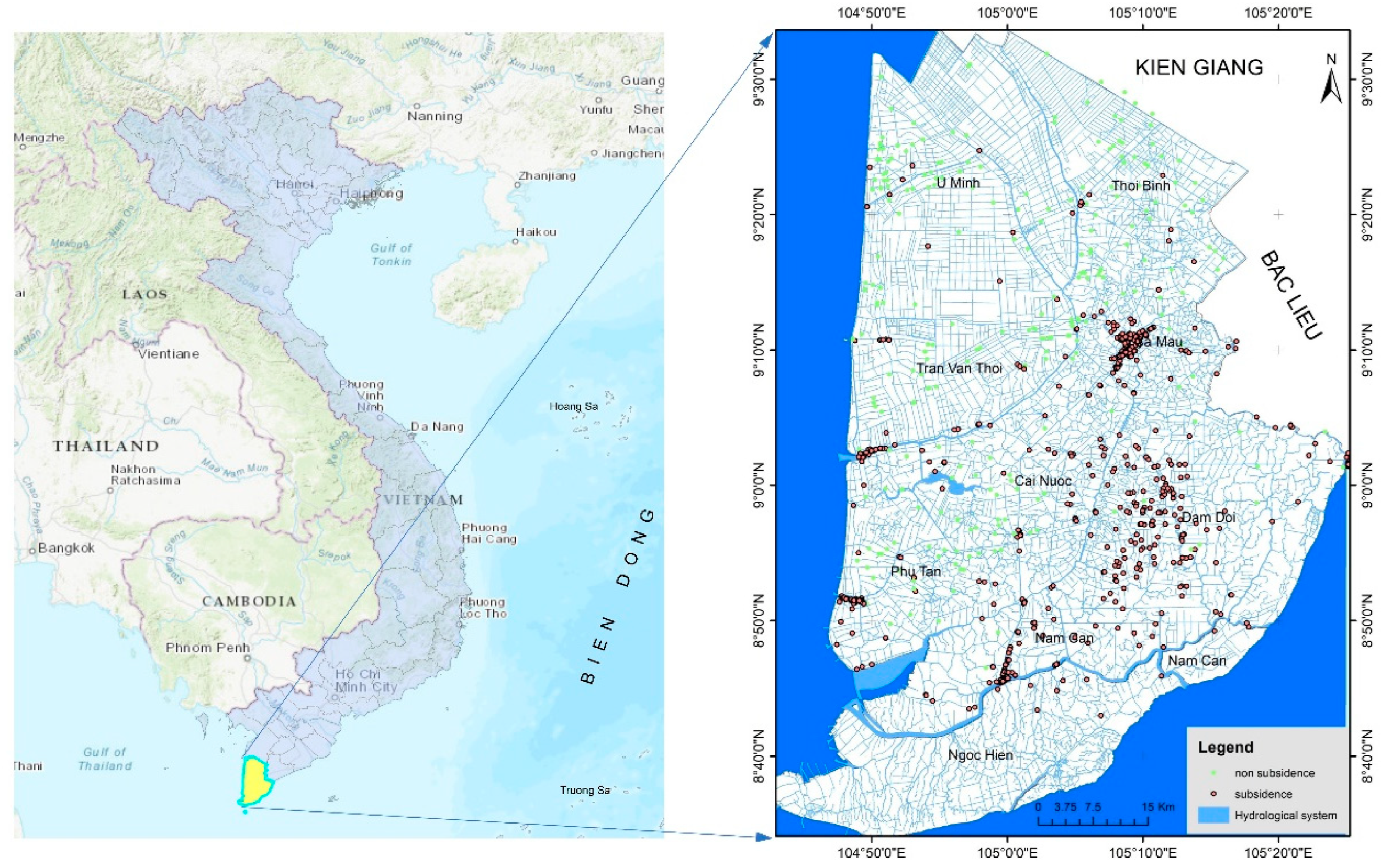
2.1. Topographical and soil characteristics
2.2. Hydrological Characteristics
2.3. Current Water Usage Situation
3. Research Methodology
3.1. AdaBoost
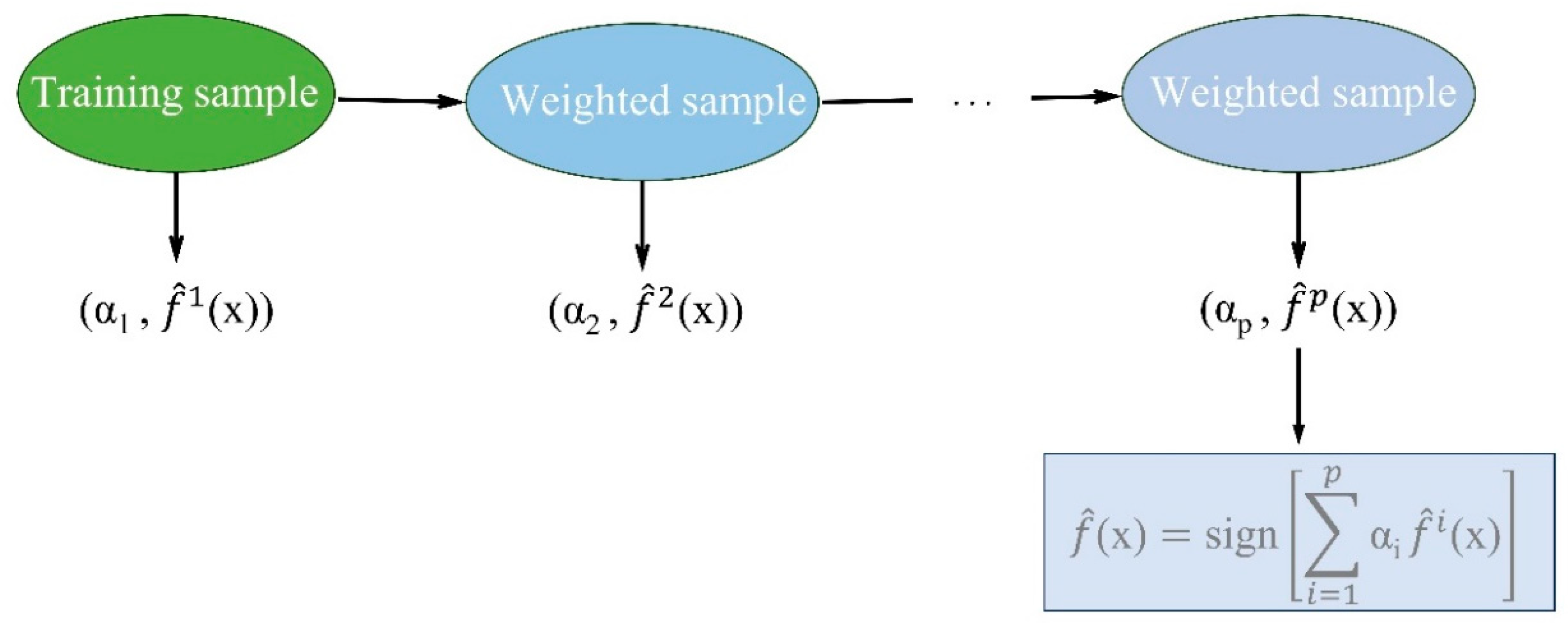
3.2. Gradient Boosting
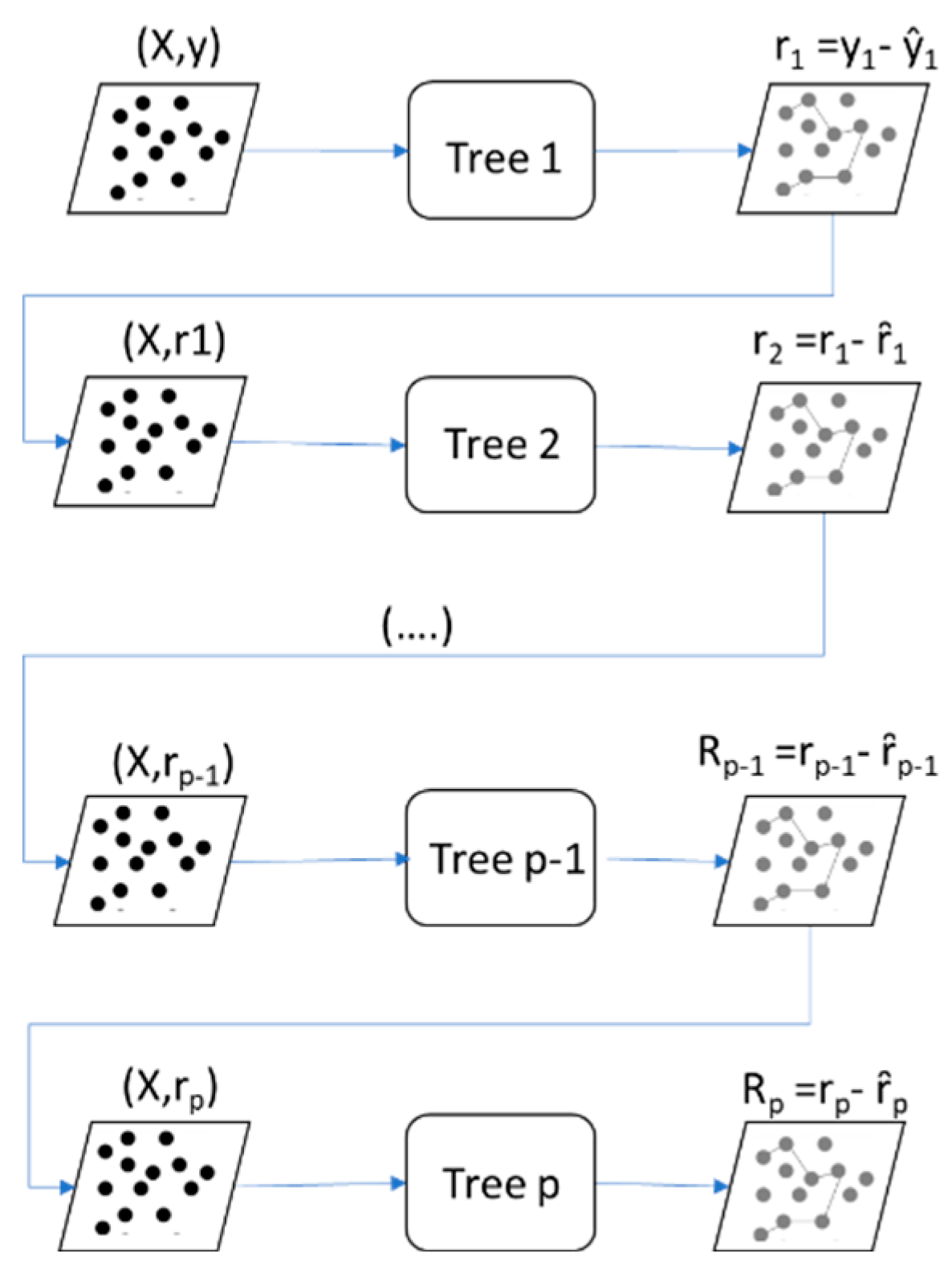
3.3. XGBoost (Extreme Gradient Boosting)
- −
- XGBoost starts by constructing a weak decision tree, possibly a very small one.
- −
- Computing the Gradient of the Loss Function: After having a weak tree, XGBoost calculates the gradient of the loss function (typically mean squared error in regression or log loss in classification) with respect to the data points. This gradient reflects the discrepancy between the current predictions and the actual values.
- −
- Building the Next Tree to Reduce Gradient: XGBoost proceeds to construct another decision tree with the aim of optimizing the reduction in gradient (the difference between predictions and actual values). This yields a new model with improved predictive performance compared to the previous one.
- −
- Combining the New Tree with Previous Trees: XGBoost integrates this new tree into the overall model in addition to the previously built trees, creating a stronger model.
- −
- Iterating the Process: This process is repeated until a predefined number of trees (or tree layers) is reached or when the loss function no longer decreases significantly.
- −
- The outstanding capabilities of XGBoost
4. Data
4.1. The inventory points of land subsidence
4.2. Influence Factors on the subsidence susceptibility Model
4.3. Data standardization
5. Results and Discussion
5.1. Evaluate the importance of the model's input variables
5.2. Evaluate model performance
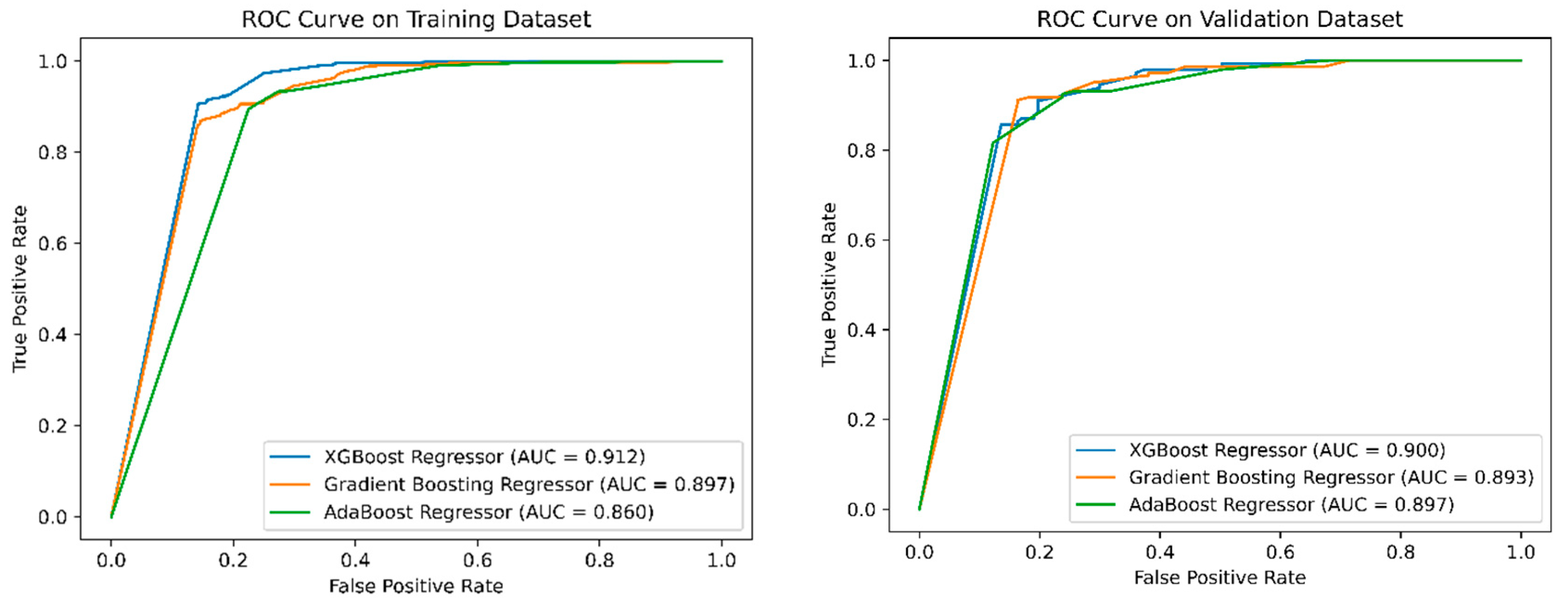
5.3. Discussion
6. Conclusion
Author Contributions
Funding
Conflicts of Interest
References
- Zhang, Y.; Xue, Y.-Q.; Wu, J.-C.; Yu, J.; Wei, Z.-X.; Li, Q.-F. Land subsidence and earth fissures due to groundwater withdrawal in the Southern Yangtse Delta, China. Environmental Geology. 2008, 55, 751–762. [Google Scholar] [CrossRef]
- Rahmati, O.; Golkarian, A.; Biggs, T.; Keesstra, S.; Mohammadi, F.; Daliakopoulos, I.N. Land subsidence hazard modeling: Machine learning to identify predictors and the role of human activities. Journal of Environmental Management. 2019, 236, 466–480. [Google Scholar] [CrossRef] [PubMed]
- Abdollahi, S.; Pourghasemi, H.; Ghanbarian, G.; Safaeian, R. Prioritization of effective factors in the occurrence of land subsidence and its susceptibility mapping using an SVM model and their different kernel functions. Bulletin of Engineering Geology and the Environment. 2019, 78, 4017–4034. [Google Scholar] [CrossRef]
- Hakim, W.; Fadhillah, M.; Park, S.; Pradhan, B.; Won, J.; Lee, C. InSAR time-series analysis and susceptibility mapping for land subsidence in Semarang, Indonesia using convolutional neural network and support vector regression. Remote Sensing of Environment. 2023, 287, 113453. [Google Scholar] [CrossRef]
- Shi, L.; Gong, H.; Chen, B.; Zhou, C. Land subsidence prediction induced by multiple factors using machine learning method. Remote Sensing. 2020, 12, 4044. [Google Scholar] [CrossRef]
- Rafiei Sardooi, E.; Pourghasemi, H.R.; Azareh, A.; Soleimani Sardoo, F.; Clague, J.J. Comparison of statistical and machine learning approaches in land subsidence modelling. Geocarto international. 2022, 37, 6165–85. [Google Scholar] [CrossRef]
- Bui, D.T.; Shahabi, H.; Shirzadi, A.; Chapi, K.; Pradhan, B.; Pourghasemi, H.R.; Khosravi, K.; Panahi, M.; Bin Ahmad, B.; Lee, S. Land subsidence susceptibility mapping in south korea using machine learning algorithms. Sensors. 2018, 18, 2464. [Google Scholar]
- Wang, H.; Jia, C.; Ding, P.; Feng, K.; Yang, X.; Zhu, X. Analysis and prediction of regional land subsidence with InSAR technology and machine learning algorithm. KSCE Journal of Civil Engineering. 2023, 27, 782–793. [Google Scholar] [CrossRef]
- Mohammadifar, A.; Gholami, H.; Golzari, S. Stacking-and voting-based ensemble deep learning models (SEDL and VEDL) and active learning (AL) for mapping land subsidence. Environmental Science and Pollution Research. 2023, 30, 26580–2695. [Google Scholar] [CrossRef] [PubMed]
- Erban, L.E.; Gorelick, S.M.; Zebker, H.A. Groundwater extraction, land subsidence, and sea-level rise in the Mekong Delta, Vietnam. Environmental Research Letters. 2014, 9, 084010. [Google Scholar] [CrossRef]
- Freund, Y.; Schapire, R.E. Experiments with a New Boosting Algorithm. In Proceedings of the Thirteenth International Conference on International Conference on Machine Learning, Bari, Italy, 3–6 July 1996; Morgan Kaufmann Publishers Inc.: San Francisco, CA, USA, 1996; pp. 148–156. [Google Scholar]
- Friedman, J.H. Greedy function approximation: a gradient boosting machine. Annals of statistics. 2001, 29, 1189–1232. [Google Scholar] [CrossRef]
- Bubeck, S. Convex optimization: Algorithms and complexity. Foundations and Trends® in Machine Learning. 2015, 8, 231–357. [Google Scholar] [CrossRef]
- (BGR), Federal Office of Civil Protection and Disaster Assistance (BBK) on behalf of the German Corporation for International Cooperation GmbH (GIZ) and Federal Institute for Geosciences and Natural Resources. 2019. 'EMSN062: Assessing changes in ground subsidence rates, Mekong Delta, Vietnam', Emergency Management Service - Mapping, Copenicus.
- Minderhoud, PSJ. Modelling Mekong Delta Subsidence, Challenges and How to Improve Quantifications. In Conference proceedings of the 4th Asia Pacific Meeting on Near Surface Geoscience & Engineering, Ho Chi Minh, Vietnam, 30 November – 2 December 2021.
- de Wit, K.; Lexmond, B.R.; Stouthamer, E.; Neussner, O.; Dörr, N.; Schenk, A.; Minderhoud, P.S.J. Identifying causes of urban differential subsidence in the Vietnamese Mekong Delta by combining InSAR and field observations. Remote Sensing. 2021, 13, 189. [Google Scholar] [CrossRef]
- Zamanirad, M.; Sarraf, A.; Sedghi, H.; Saremi, A.; Rezaee, P. Modeling the influence of groundwater exploitation on land subsidence susceptibility using machine learning algorithms. Natural Resources Research. 2020, 29, 1127–1141. [Google Scholar] [CrossRef]
- Li, H.; Zhu, L.; Dai, Z.; Gong, H.; Guo, T.; Guo, G.; Wang, J.; Teatini, P. Spatiotemporal modeling of land subsidence using a geographically weighted deep learning method based on PS-InSAR. Science of The Total Environment. 2021, 799, 149244. [Google Scholar] [CrossRef] [PubMed]
- NAWAPI. Water resources yearbook for the South Central region in 2021 (Department of Statistics of Ca Mau), Vietnam, 2022.
- Khan, H.; Shafique, M.; Khan, M.A.; Bacha, M.A.; Shah, S.U.; Calligaris, C. Landslide susceptibility assessment using Frequency Ratio, a case study of northern Pakistan. The Egyptian Journal of Remote Sensing and Space Science. 2019, 22, 11–24. [Google Scholar] [CrossRef]
- Khuc, T.D.; Truong, X.Q.; Tran, V.A.; Bui, D.Q.; Bui, D.P.; Ha, H.; Tran, T.H.M.; Pham, T.T.T.; Yordanov, V. Comparison of Multi-Criteria Decision Making, Statistics, and Machine Learning Models for Landslide Susceptibility Mapping in Van Yen District, Yen Bai Province, Vietnam. International Journal of Geoinformatics. 2023, 19. [Google Scholar]
- Truong, X.Q.; Nguyen, H.D.D; Do, T.H.; Tran, N.D.; Do, T.T.N.; Tran, V.A.; Yordanov, V.; Maria A., B.; Khuc, T.D. Random forest analysis of land use and land cover change using sentinel-2 data in van yen, yen bai province, Vietnam. In Advances in Geospatial Technology in Mining and Earth Sciences, Proceedings of the 2nd International Conference on Geo-spatial Technologies and Earth Resources, Hanoi, Vietnam, October 2022; Springer, Cham.: Springer Nature Switzerland AG, 2023; pp. 429–445. [Google Scholar]
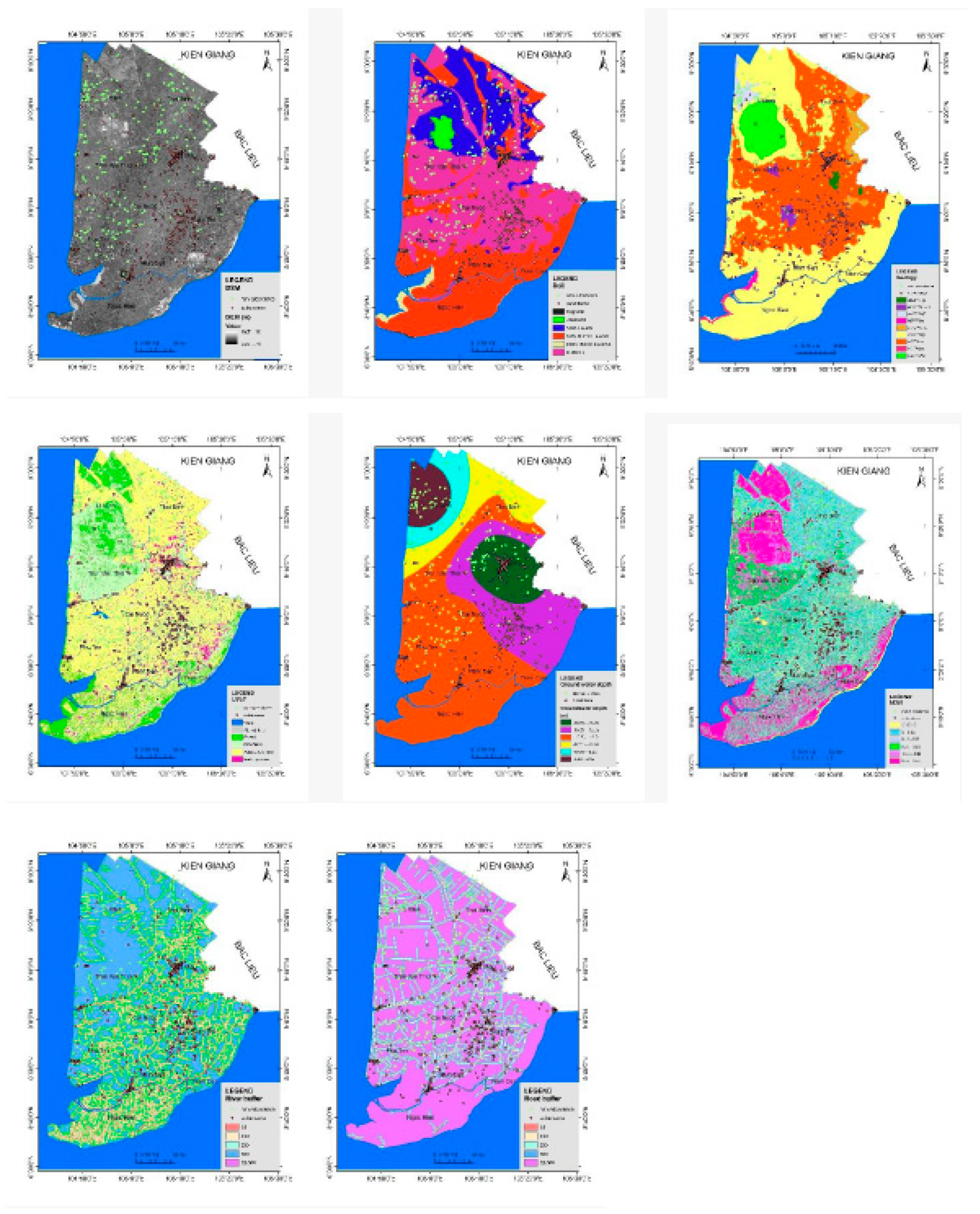
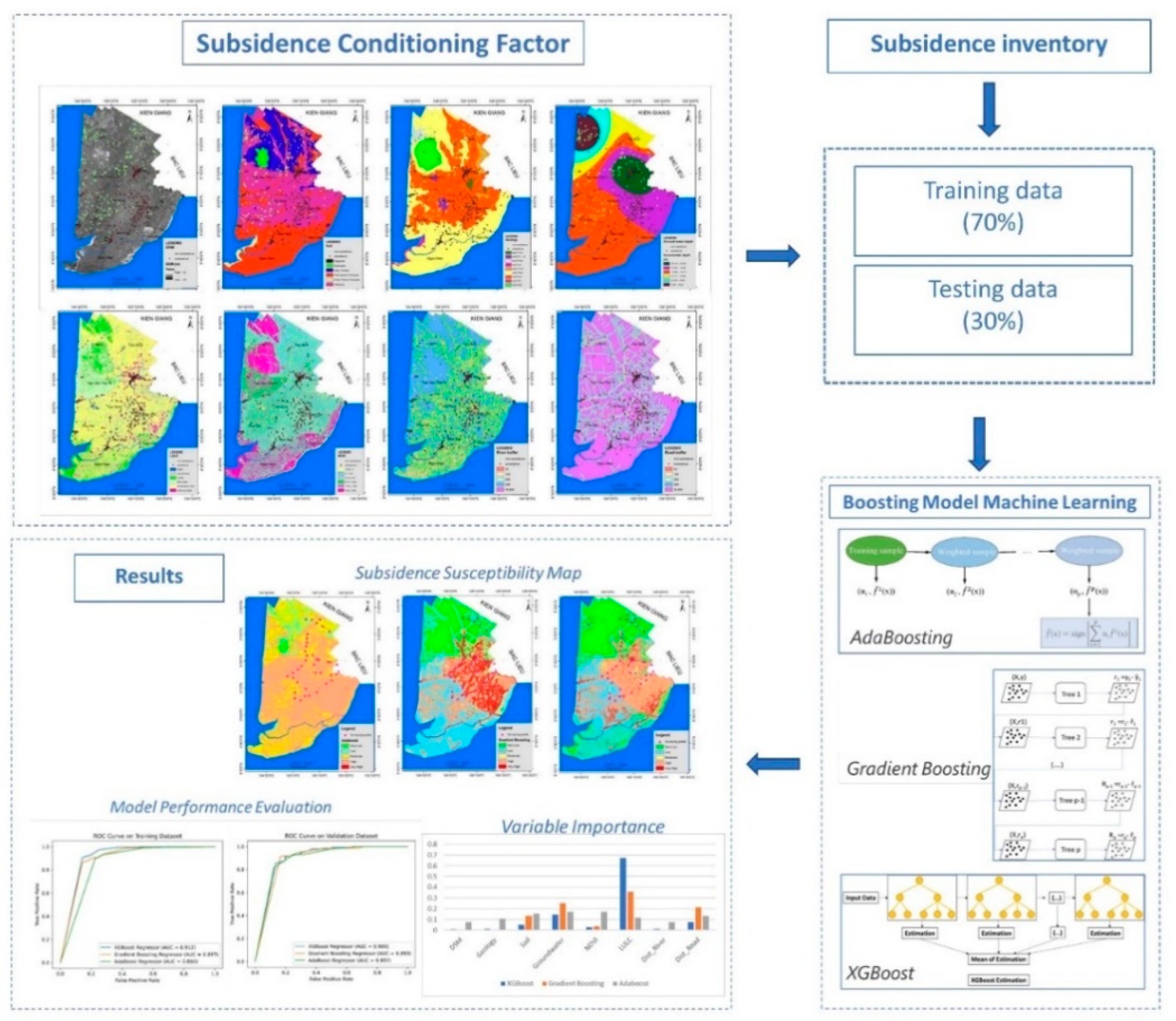
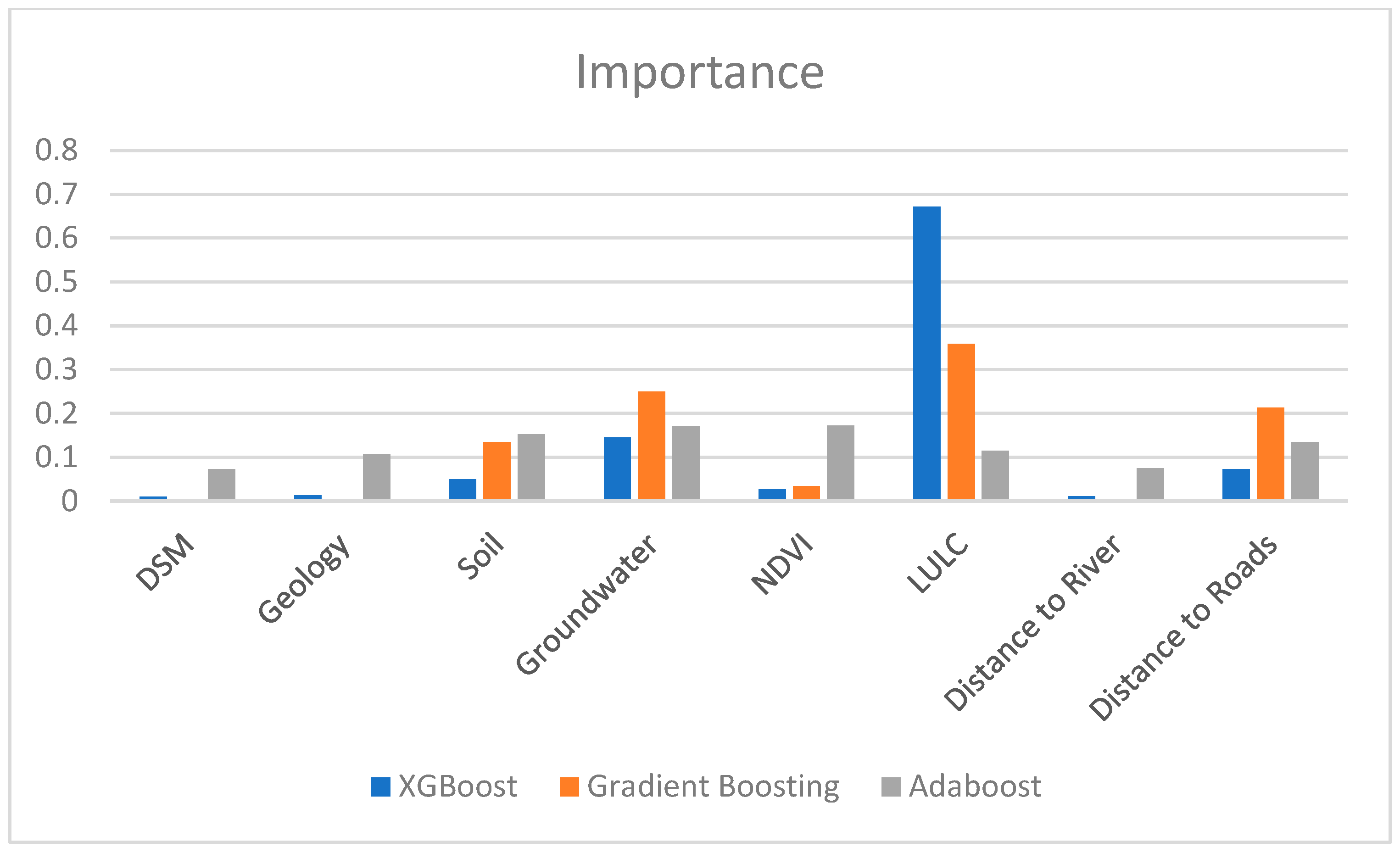
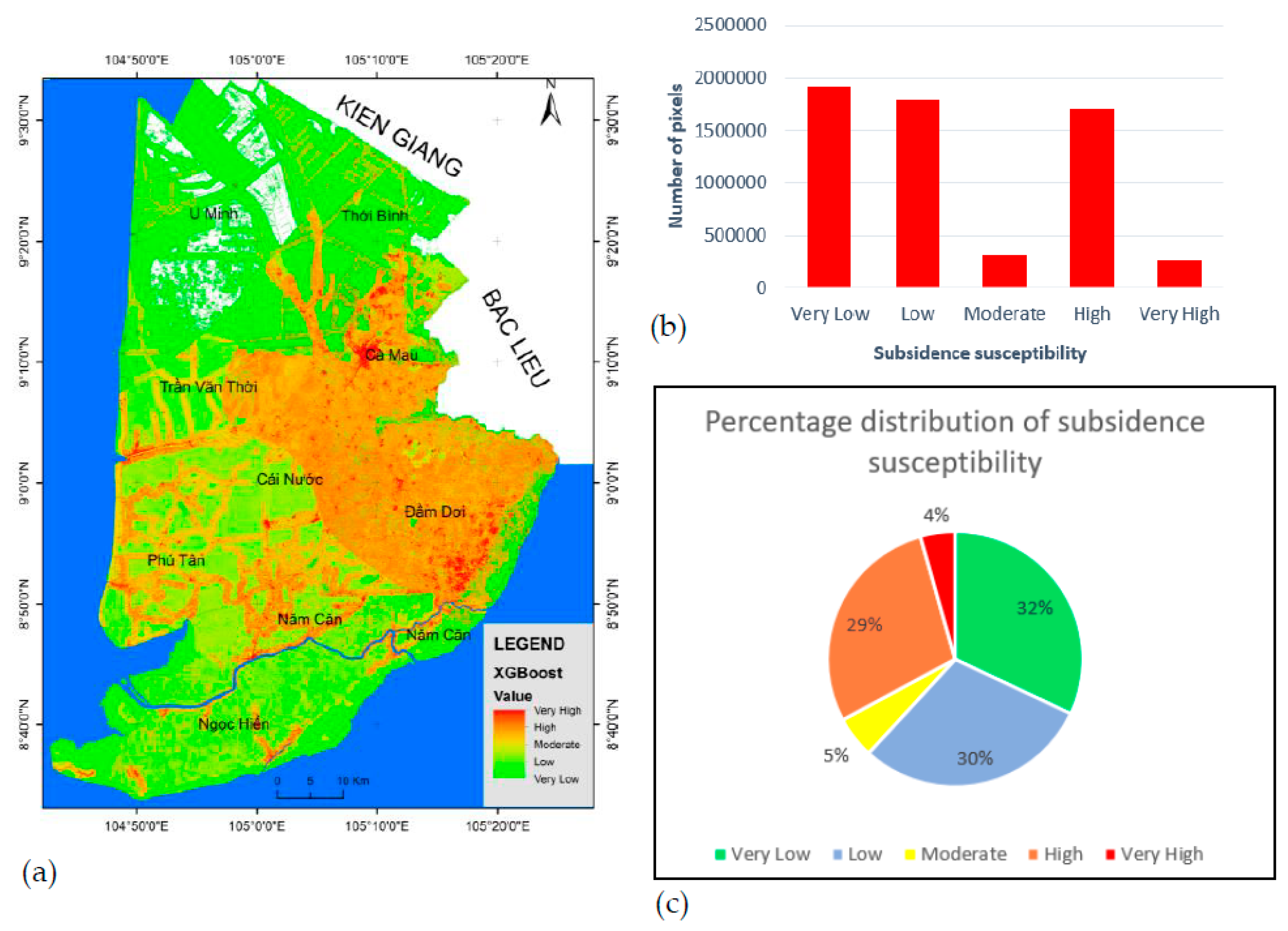
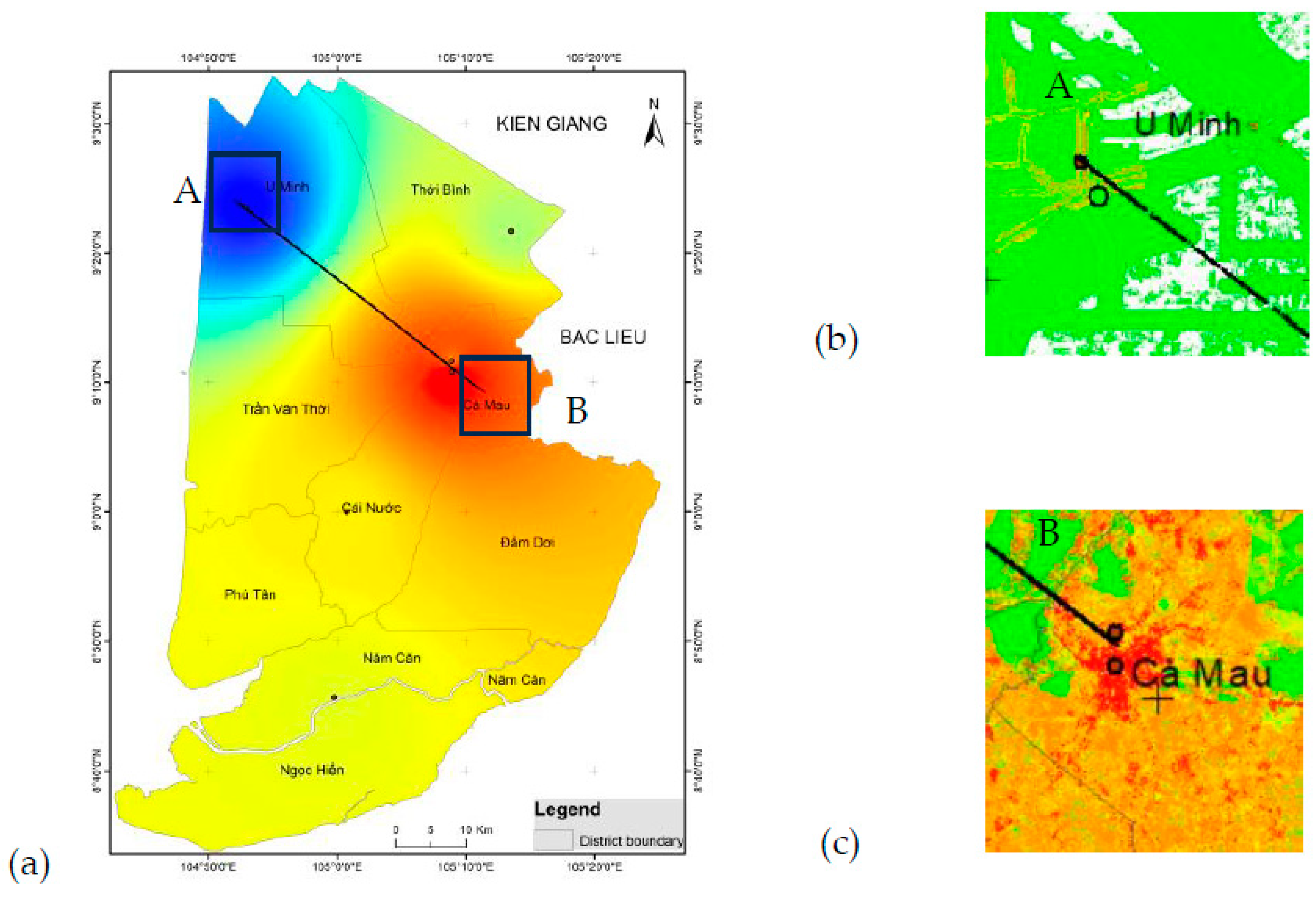
| Factor | Sub-factor | LS points | %Land subsidence | Class pixels | % Class pixel | FR |
| (1)<[-7.431] | 3 | 0.29 | 28948 | 0.496 | 0.586 | |
| Elevation (m) | (2) [-7.431m-(-0.568)m] | 23 | 2.23 | 532631 | 9.135 | 0.244 |
| (3) [-0.568m- 1.490m] | 152 | 14.73 | 1908970 | 32.739 | 0.450 | |
| (4) [1.490m-5.608m] | 738 | 71.51 | 2946996 | 50.541 | 1.415 | |
| (5) [5.608m-14.529m] | 115 | 11.14 | 387369 | 6.643 | 1.677 | |
| (6) [>14.529m] | 1 | 0.10 | 25941 | 0.445 | 0.218 | |
| (1) Regosols | 0 | 0.00 | 4800 | 0.080 | 0.000 | |
| Soil | (2) Arenosols | 0 | 0.00 | 94229 | 1.579 | 0.000 |
| (3) Salic Fluvisols | 30 | 2.92 | 1098253 | 18.407 | 0.159 | |
| (4) Orthi- Thionic fl | 508 | 49.51 | 2098530 | 35.171 | 1.408 | |
| (5) Proto- Thionic fl | 0 | 0.00 | 145226 | 2.434 | 0.000 | |
| (6) > Histosols | 488 | 47.56 | 2525584 | 42.329 | 1.124 | |
| (1) (abQe ) | 2 | 0.20 | 266 | 0.498 | 0.393 | |
| Geology | (2) (abQer Ho) | 1 | 0.10 | 531 | 0.994 | 0.098 |
| (3) (abTerţ) | 0 | 0.00 | 1 | 0.002 | 0.000 | |
| (4) (amQe) | 13 | 1.27 | 767 | 1.436 | 0.885 | |
| (5) (amQerţ) | 0 | 0.00 | 168 | 0.315 | 0.000 | |
| (6) (bQQe) | 7 | 0.68 | 1399 | 2.619 | 0.261 | |
| (7) (mQQe) | 395 | 38.61 | 24504 | 45.873 | 0.842 | |
| (8) (mQQe ţ) | 593 | 57.97 | 22656 | 42.413 | 1.367 | |
| (9) (mbQe) | 8 | 0.78 | 344 | 0.644 | 1.214 | |
| (10) (mbQer Ho) | 4 | 0.39 | 2781 | 5.206 | 0.075 | |
| (1) [(-18.191m)–(-15.288m)] | 255 | 24.71 | 561100 | 9.831 | 2.513 | |
| Ground water | (2) [(-15.288m)–(-13.930m)] | 262 | 25.39 | 1202946 | 21.077 | 1.205 |
| (3) [(-13.930m)–(-12.713m)] | 478 | 46.32 | 2672539 | 46.826 | 0.989 | |
| (4) [(-12.713m)–(-10.933m)] | 16 | 1.55 | 579125 | 10.147 | 0.153 | |
| (5) [(-10.933m)–(-8.591m)] | 2 | 0.19 | 344049 | 6.028 | 0.032 | |
| (6) [(-8.591m)–(-6.251m)] | 19 | 1.84 | 347630 | 6.091 | 0.302 | |
| (1) [(-0.445)–(-0.055)] | 14 | 1.36 | 444115 | 7.617 | 0.178 | |
| NDVI | (2) [(-0.055)–0.116] | 465 | 45.06 | 1025564 | 17.589 | 2.562 |
| (3) [0.116-0.271] | 282 | 27.33 | 1205154 | 20.669 | 1.322 | |
| (4) [0.271-0.437] | 196 | 18.99 | 1304528 | 22.373 | 0.849 | |
| (5) [0.437-0.619] | 66 | 6.40 | 922437 | 15.820 | 0.404 | |
| (6) [0.619-0.918] | 9 | 0.87 | 929057 | 15.933 | 0.055 | |
| (1) Water | 22 | 2.09 | 9092376 | 41.576 | 0.050 | |
| LULC | (2) Alluvial land | 3 | 0.29 | 120858 | 0.553 | 0.517 |
| (3) Forest | 18 | 1.71 | 1652162 | 7.555 | 0.227 | |
| (4) Rice fields | 325 | 30.92 | 3656870 | 16.722 | 1.849 | |
| (5) Aquaculture land | 116 | 11.04 | 6774991 | 30.980 | 0.356 | |
| (6) Build up areas | 567 | 53.95 | 571849 | 2.615 | 20.631 | |
| Distance to Road | (1) 0-50m | 203 | 19.67 | 539964 | 9.291 | 2.117 |
| (2) 50-100m | 197 | 19.09 | 418632 | 7.203 | 2.650 | |
| (3) 100-200m | 264 | 25.58 | 758709 | 13.055 | 1.959 | |
| (4) 200-500m | 188 | 18.22 | 1604568 | 27.610 | 0.660 | |
| (5) >500m | 180 | 17.44 | 2489723 | 42.841 | 0.407 | |
| Distance to River | (1) 0-50m | 208 | 20.16 | 325502 | 5.601 | 3.599 |
| (2) 50-100m | 116 | 11.24 | 283743 | 4.882 | 2.302 | |
| (3) 100-200m | 182 | 17.64 | 500150 | 8.606 | 2.049 | |
| (4) 200-500m | 220 | 21.32 | 1218897 | 20.974 | 1.016 | |
| (5) >500m | 306 | 29.65 | 3483304 | 59.937 | 0.495 |
| TP | TN | FP | FN | Sensitivity | specificity | AUC | ACC | ||
| Adaboost model (ADB) | 736 | 663 | 92 | 165 | 0.817 | 0.878 | 0.903 | 0.845 | |
| Gradient Boosting (GB) | 711 | 711 | 117 | 117 | 0.858 | 0.858 | 0.897 | 0.858 | |
| XGBoost (XGB) | 750 | 710 | 118 | 78 | 0.906 | 0.857 | 0.912 | 0.881 | |
| TP | TN | FP | FN | Sensitivity | specificity | AUC | ACC | ||
| Adaboost model (ADB) | 137 | 93 | 54 | 10 | 0.932 | 0.633 | 0.897 | 0.78 | |
| Gradient Boosting (GB) | 133 | 123 | 24 | 14 | 0.905 | 0.837 | 0.893 | 0.870 | |
| XGBoost (XGB) | 126 | 127 | 20 | 21 | 0.857 | 0.864 | 0.9 | 0.860 | |
Disclaimer/Publisher’s Note: The statements, opinions and data contained in all publications are solely those of the individual author(s) and contributor(s) and not of MDPI and/or the editor(s). MDPI and/or the editor(s) disclaim responsibility for any injury to people or property resulting from any ideas, methods, instructions or products referred to in the content. |
© 2024 by the authors. Licensee MDPI, Basel, Switzerland. This article is an open access article distributed under the terms and conditions of the Creative Commons Attribution (CC BY) license (http://creativecommons.org/licenses/by/4.0/).





